| KALAMAZOO
ANTIQUE BOTTLE CLUB NEWS |
| Volume 20 Issue 6
Written By Allan C.Holden
February 2023
|
|
I Hear That Show Train A-Comin’!  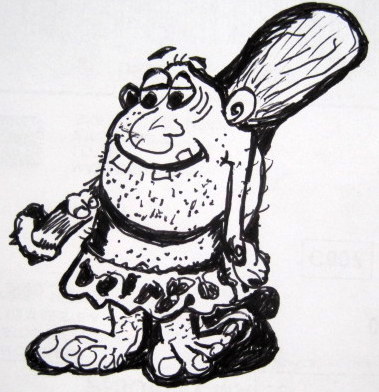 Hello
my fellow bottle clubber friends! Hello
my fellow bottle clubber friends!First let’s deal with that woolly mammoth in the room! Yes, let us focus on that greatest of all Antique Bottle Shows! The 2023 Kalamazoo Antique Bottle Show! Yes, it is steaming our way, a coming-round- the-bend! Just think! This will be our 42nd annual Kalamazoo Antique Bottle Show! Here is something worth pondering; just consider this very important fact. To demonstrate how this show has improved over the last 4 decades; “The very oldest bottles that were displayed at our first show, and they were old, today, through the miracle of modern science, and very-diligent hard work, those exact same bottles will be even older at this coming show!” You will not want to miss this big show! It’s our guarantee, or double your money back! No other club show can, or even will make that ridiculous claim! John Pastor, just mailed out the dealer contracts with a few things highlighted. This year’s show takes place from: 10:00 a.m. to 2:30 p.m. on Saturday April 8th at the Kalamazoo County Fair Grounds. The address is, 2900 Lake Street, Kalamazoo, MI 49048. From Interstate 94 take exit 80. For our dealers, a group rate of $79.00 has been negotiated with, at the Clarion Inn, located at 3640 East Cork Street at exit 80! The Clarion is only 5 minutes from the show site. The Clarion phone number is 269-381-1900. For this special rate, you must call the Hotel prior to Friday, March 24th and mention you are with the “2023 Bottle Club.” Don’t wait! This block of rooms will sell-out quickly! The club has decided to change the show hours, closing this year at 2:30. But, now more than ever please remain setup until 2:30. This year the club will be offering a free pizza lunch around noon for all dealers. There will be no hospitality suite this year. We will be listening for your feedback as we will revisit this for the 2024 Kalamazoo Antique Bottle Show. Dealer setup for the dealer tables will be 8:00 to 10:00. Two name tags will be provided per dealer and they MUST be worn. Dealers must furnish their own table covers. Table Covers Are Required! For-Sale items will be limited to: Antique bottles, jars, flasks, and related glass. Also stoneware, advertising and small table-top antiques are permitted. PLEASE! No flea-market items, no Avion Bottles, new merchandise, Jim Beam bottles, beer cans, etc. Tables should consist of at least 60% bottles, flasks, jars or related glass. Any modified and irradiated bottles, or jars, must be so marked!
Notes by: Mr. Vincent Grossi Vince has been helping me with meeting
notes, which is greatly appreciated!
1. Posting about the 2023 Antique
Bottle Show. Done✔2. Posting for the February 25th West Michigan Antique Bottle Clubs Show & Sale Done✔ 3. Juli Sheaffer was the Grand Prize Winner of the first $5.00 bottle table bottle! Juli decided to turn down the 2023 Shelby Cobra Mustang Convertible, and keep the bottle. Wise choice Juli! Done✔ 4. The Bottle Theme for this month is ‘Valentines Day’ and related bottle items. The meeting this month falls on February, 14th, Valentine’s Day; unless, that Chinese balloon is filled with anthrax and Biden or Cupid finally decide to shoot it down with an arrow. Done ✔ 5. We are still discussing plans for a road trip to a West Michigan Bottle Club Meeting in 2023. Also, get with Vince if you are interested in a road trip to the Grand Rapids Club show on February 25th. Done✔ 6. Also, there was some interest in a road trip to the Coin Club’s Auction Night this year. Done✔ LAST MEETING You guessed it! We had a lot of fun at the January Meeting with a real nice turnout! Looking about the room we saw the following smiling faces! Gary Dean, Brian Wages, Katie Wages, Len Sheaffer, Juli Sheaffer, Kevin Siegfried, Dave Wilkins, Ed Nickerson, Ron Smith, Rob Knolle, Scott Hendrichsen, Vincent Grossi and Al Holden. We had a little bottle contest last month, for the smallest bottle. Vince and I, missed the chance to record the smallest bottle winner (we are working to do better!) We both wanted to say it was Dave Wilkins from Gobles? 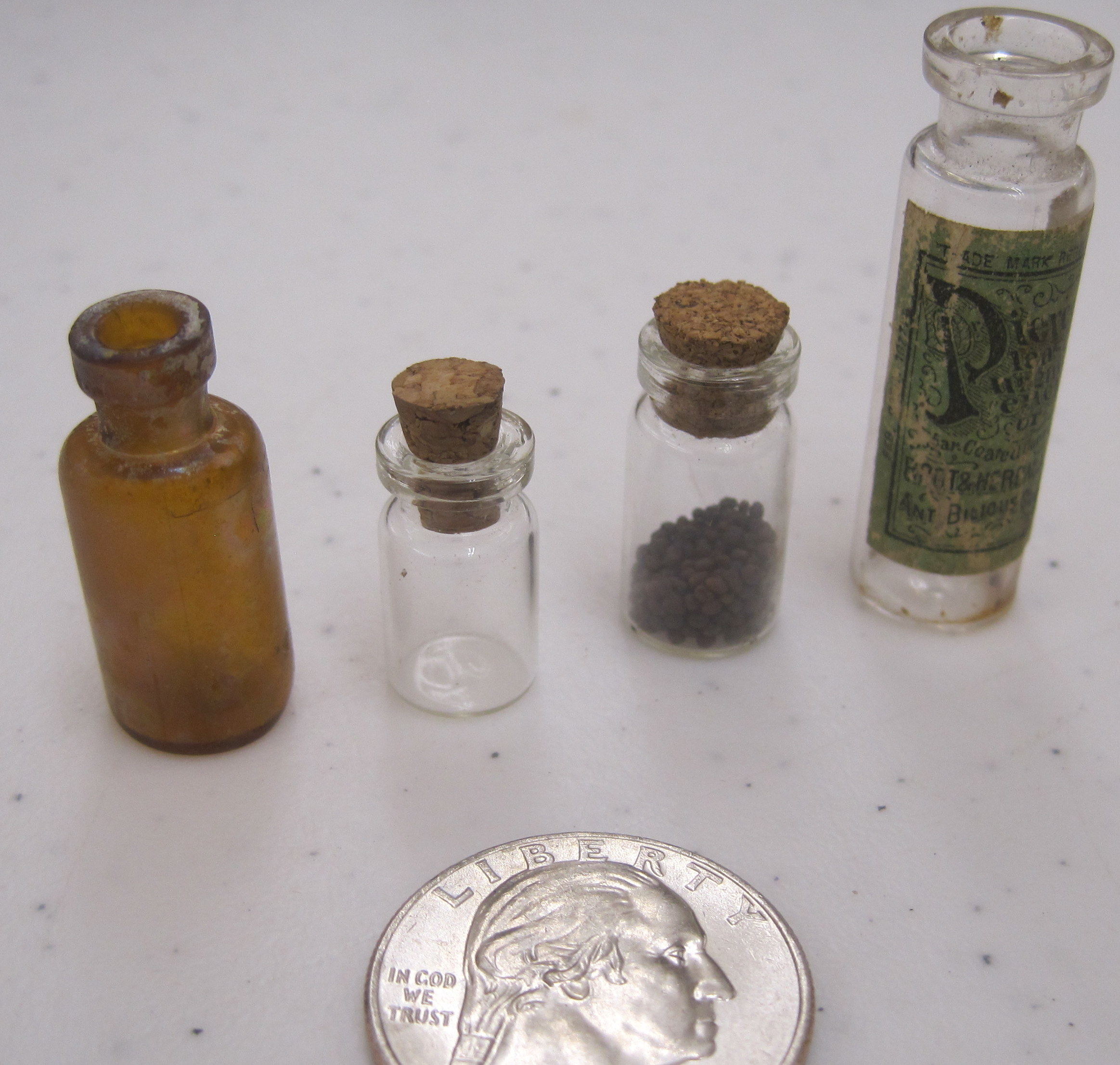 The two smallest bottles
entered were both clear color, and each one was
corked. Many collectors will group these tiny
bottles as medicine bottles. But, they could
have been used for a variety of products, very often
containing compounds of opium. I believe without the
FDA riding herd, druggist knew how potent these
drugs could be, so the amount prescribed required a
small dose. The two smallest bottles
entered were both clear color, and each one was
corked. Many collectors will group these tiny
bottles as medicine bottles. But, they could
have been used for a variety of products, very often
containing compounds of opium. I believe without the
FDA riding herd, druggist knew how potent these
drugs could be, so the amount prescribed required a
small dose.I have seen druggist bottles from Upjohn, which contain forms of mercury or “ mercurials,” used in the treatment of syphilis and skin diseases, were dispensed by the local druggist in very tiny bottles. In our small bottle competition, there was only one with an actual label. That bottle had contained a product we have seen before. It was Dr. Pierces Pleasant Purgative Pills. Dr. Ray Pierce was born in New York, August 6, 1840. He Graduated from the “Eclectic 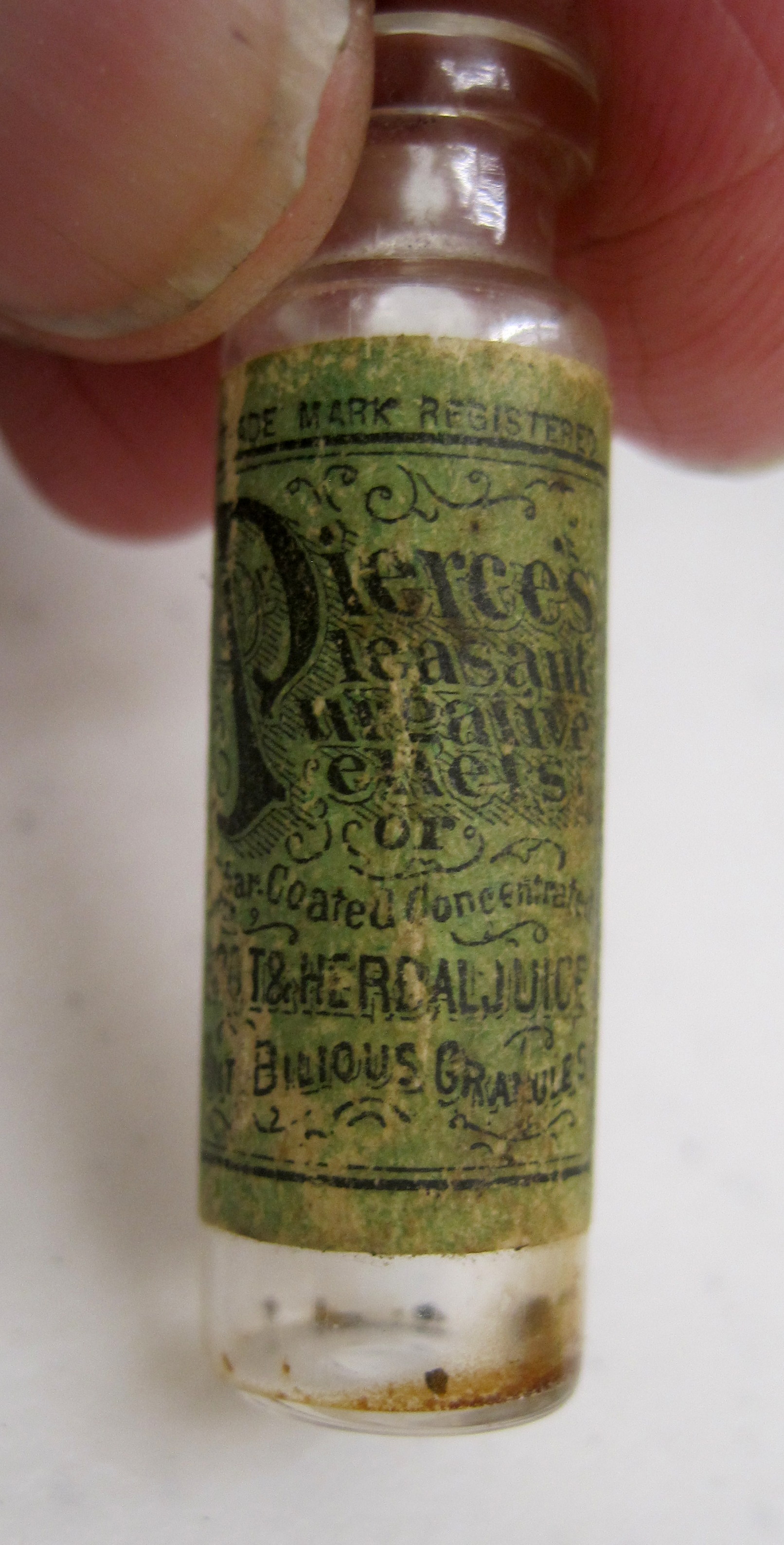 Medical College”
in 1865, he moved to New York in 1867 where he
started: Medical College”
in 1865, he moved to New York in 1867 where he
started:“The World’s Dispensary,” a mail-order patent medicine business. To advertise his cures, Dr. Pierce made aggressive use of newspaper advertisements featuring patient testimonials, billboards, and postcards, in addition to publishing, “The people’s Common Sense Medical Advisor.” (really just a collection of advertisement for his products). A savvy businessman, Pierce, plastered his name on almost everything he sold, from “Dr. Pierce’s Pleasant Pellets” and “Dr. Pierce’s Extract of Smart-Weed” to “Dr. Pierce’s Golden Medical Discovery” which for the most part was a mix of quinine, opium, and alcohol. Dr. Pierce’s business was, in 1878, bringing in half-a-million a years, (around $13 million today.) In 1878, Dr. Pierce opened the well-appointed Invalids’ Hotel and Surgical Institute. To demonstrate to the world that he wasn’t a crook, he campaigned to represent the 31st district of New York in the state Senate, where he served one term. Never in all history have we ever questioned the honesty of a politician! Perhaps you remember this image from a past newsletter. 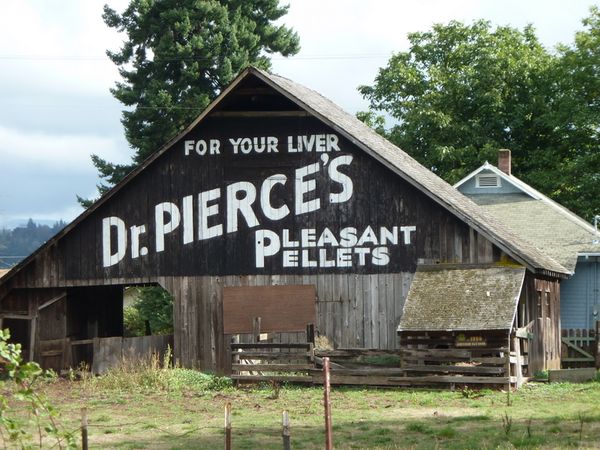 I actually remember seeing these in my travels, along with “Mail Pouch Tobacco” “See Ruby Falls” and “Wall Drugs.” New members, Brian and Katie Wages, actually joined the club a couple months back, and this was their first real meeting! It was neat to meet them! They drove from Burlington. MI. Which is over an one hour drive. They are avid collectors and had some nice bottles at our meeting. I knew they were coming but I didn’t have a photo tag ready. Duh! But interestingly, Katie passed out sticky-back name tags for everyone! A great idea! I forgot to take mine off and when I got home the wife said, “So you are Al Holden!” I did scribble out a small tag for my photos, but a couple items were un-named. One was a beautiful 7-UP -green, sample- sized, 3-IN-ONE-Oil bottle. It is a really neat 3-sided poison bottle style, with those knobby warning bumps! I had not seen this variant before. My research shows it dates to the very early 1900's. I would love to credit this to the owner next month. Brian and Katie Wages brought in a beautiful deep amber bitters-style bottle embossed “MUNSON’S PAW-PAW.” My first thought was, “here is a local beauty (Paw Paw) one that I was unfamiliar with.” It is not even a Michigan bottle . . . it is from Florida! 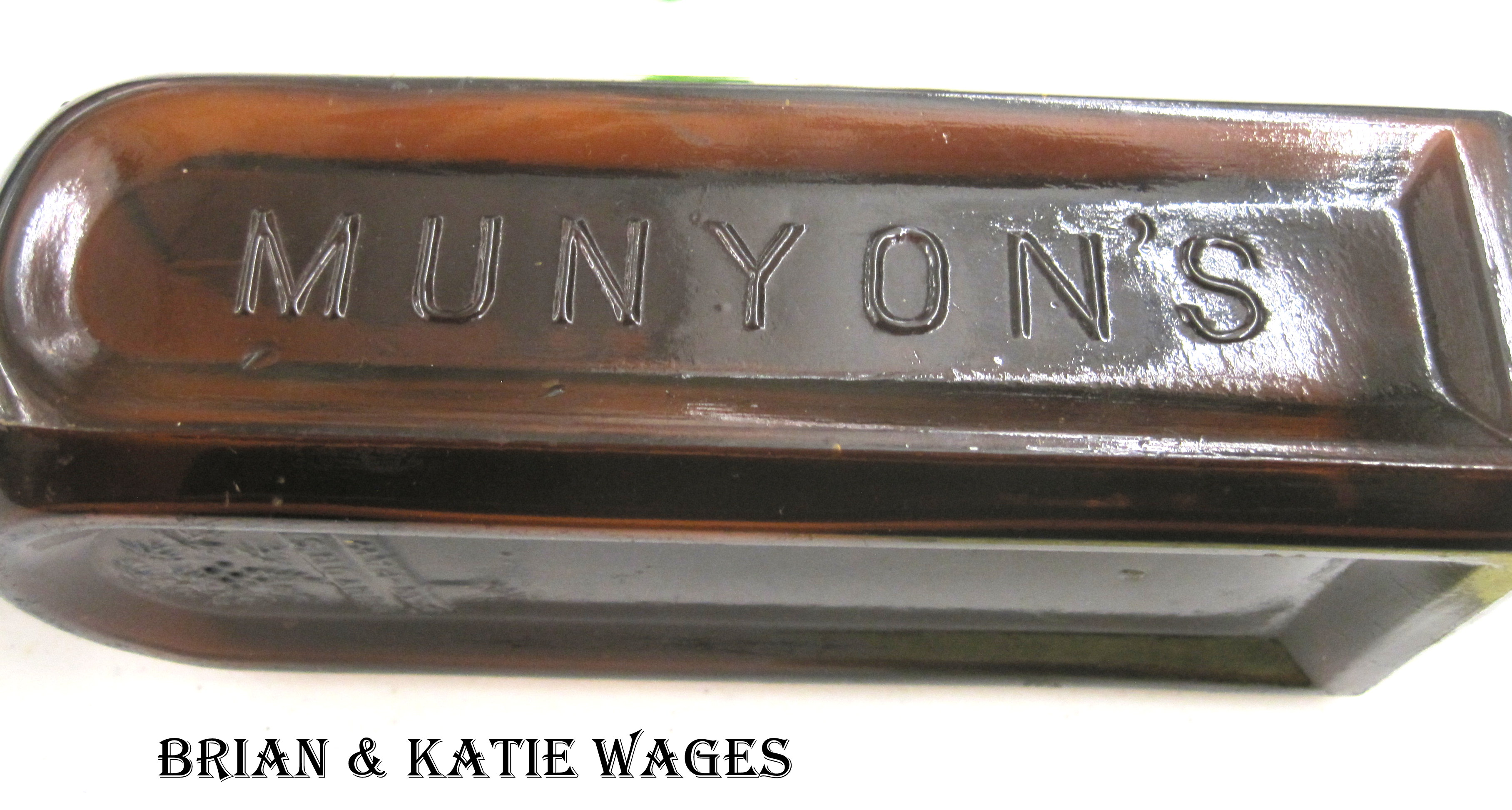 James Munson was born in Thompson
Ct. into a very poor family. In his early teens,
James started formulating therapeutics of roots and
herbs and worm squeezings , selling them door to
door. James Munson was born in Thompson
Ct. into a very poor family. In his early teens,
James started formulating therapeutics of roots and
herbs and worm squeezings , selling them door to
door.From 1861 - 1865 Munson served in the Union Army. In 1867, James becomes a successful publisher, editor, theatrical booking agent. In 1892, Dr. James Munyon opens Munyon Homeopathic Remedy Company, in Philadelphia. In 1902, Construction starts on a private Florida island where Munson built the Hotel Hygeia, located of Palm Beach, FL. In 1903, James Munyon creates Munyon’s Paw-Paw, the crown jewel of his homeopathic remedy company. It was made from a combination of ingredients, blended in a drink made from fermented Papaya. Get a designated driver! In 1904, Hotel Hygeia opens it’s doors and becomes a must visit destination for those wintering in Palm Beach. It is also a key distribution point for Munyon’s Paw-Paw. The island has numerous tropical trees including: papaya, oranges, grapefruit and hibiscus, all of which are in the PAW-PAW formulation. In 1918 James Munyon passes away, with his death, the legacy fades. The once household name and famed Munyon’s Paw-Paw tonic are largely forgotten. The only remnant of the story is a small island near Palm Beach, FL that bears his name. BUT WAIT! Munyon's Paw-Paw has been reintroduced in 2022 as an American *Aperitif by a couple of South Florida locals hoping to make it a household name again! The modern perspective of this vintage brand is an American twist on a classic low proof *Aperitif. *(alcoholic beverage taken before a meal as an appetizer) Unlike other brands, none of the ingredients are kept secret. Everyone should Know Their Spirit! It's NOT made to cure the same ailments that Munyon had promised, but to revive an incredible piece of Florida's history for people to fall in love with once more. Get this, this newly released product is in an amber glass bottle nearly identical to the original . . . price $35.00 ea. Neat, don’t you think? Another medicine bottle Brian and Katie displayed was a 1890-1910 cough syrup 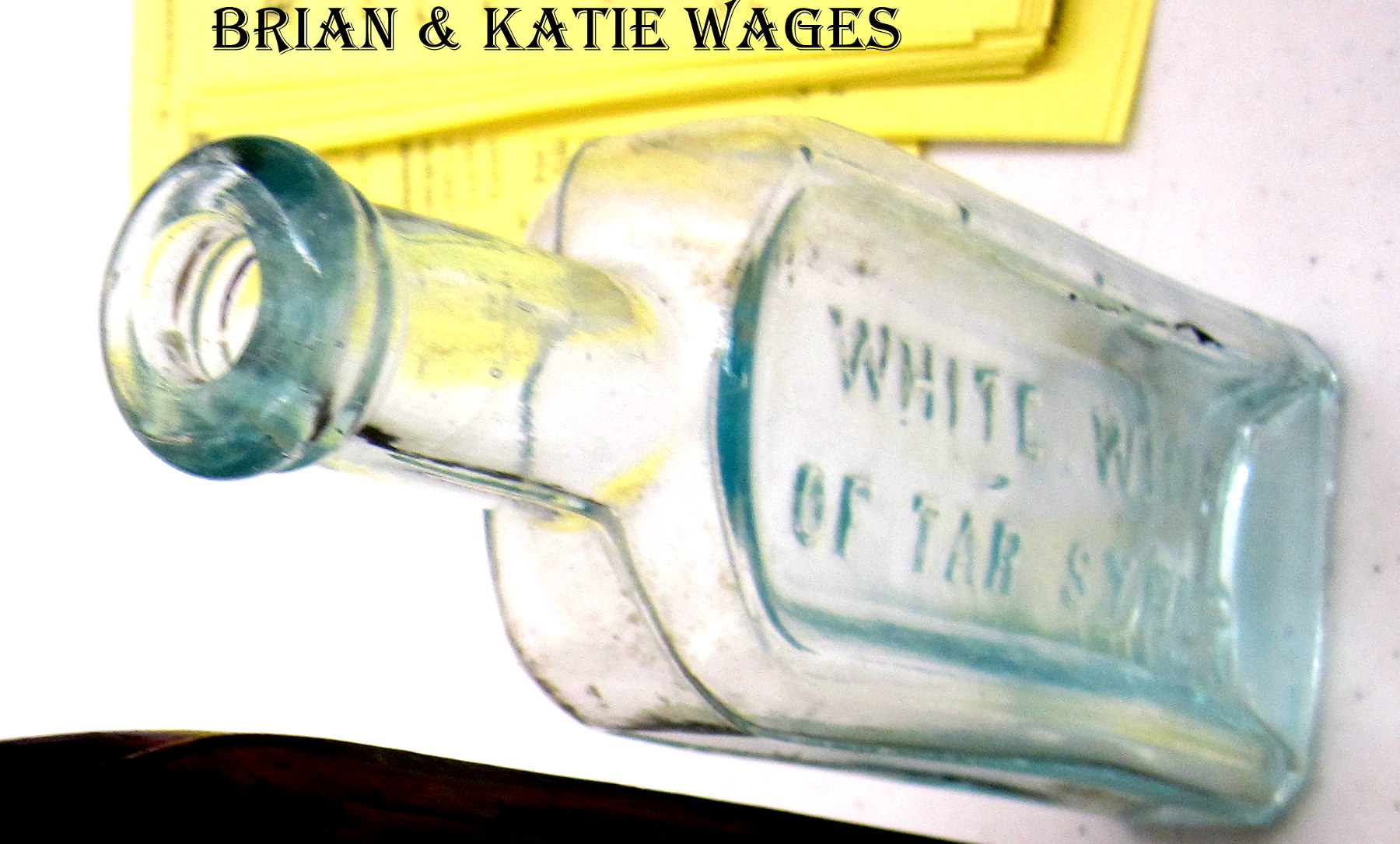 bottle, “White Wine of Tar
Syrup.” bottle, “White Wine of Tar
Syrup.”In 1820's, scientists were able to make codeine and morphine. These drugs were not fully understood at the time. Both drugs, are a type of opiate, and very addictive . . .in large quantities can be deadly! Sometimes heroin and opium were also used in cough medicines! We are talking about children’s cough syrup! This was one of those products! It is not hard to find fully labeled White Wine of Pine Tar Syrup online, just read the label! The Wages also had a Kalamazoo Zoa-Phora, Woman’s Friend bottle. We had a Kalamazoo Historian present the club with a talk about Kalamazoo’s roll in the patent medicine business. Kalamazoo was a hot bed of snake oil peddlers! During the public outcry leading up to the 1907 Pure Food and Drug Act, Colliers Magazine had some amazing cover art. I have a copy of it somewhere. The graphic shows the Government, which is depicted as a Sherlock Holmes figure, who is shining a flashlight on the floor of a dark room. It the light’s beam, are about a dozen cockroaches with human faces. On the back of each roach is the name of a snake oil manufacture, and its city of origin. Some were New York City, some were Boston, some Chicago but fully half were from Kalamazoo! Zoa-Phora was produced by Richard Pengelly, who was a Methodist minister. Pengelly, who became a physician, created a treatment for women called Zoa-Phora, “woman's friend.” It was a celery and alcohol-based medicine that was supposedly good for treating "any woman’s complaint." It was high in alcohol content, and would easily get someone bombed. His wife, Mary Pengelly, was a prohibitionist, and the leader of the Women's Christian Temperance Union in Kalamazoo. Well, I am sure everyone’s intention was good. 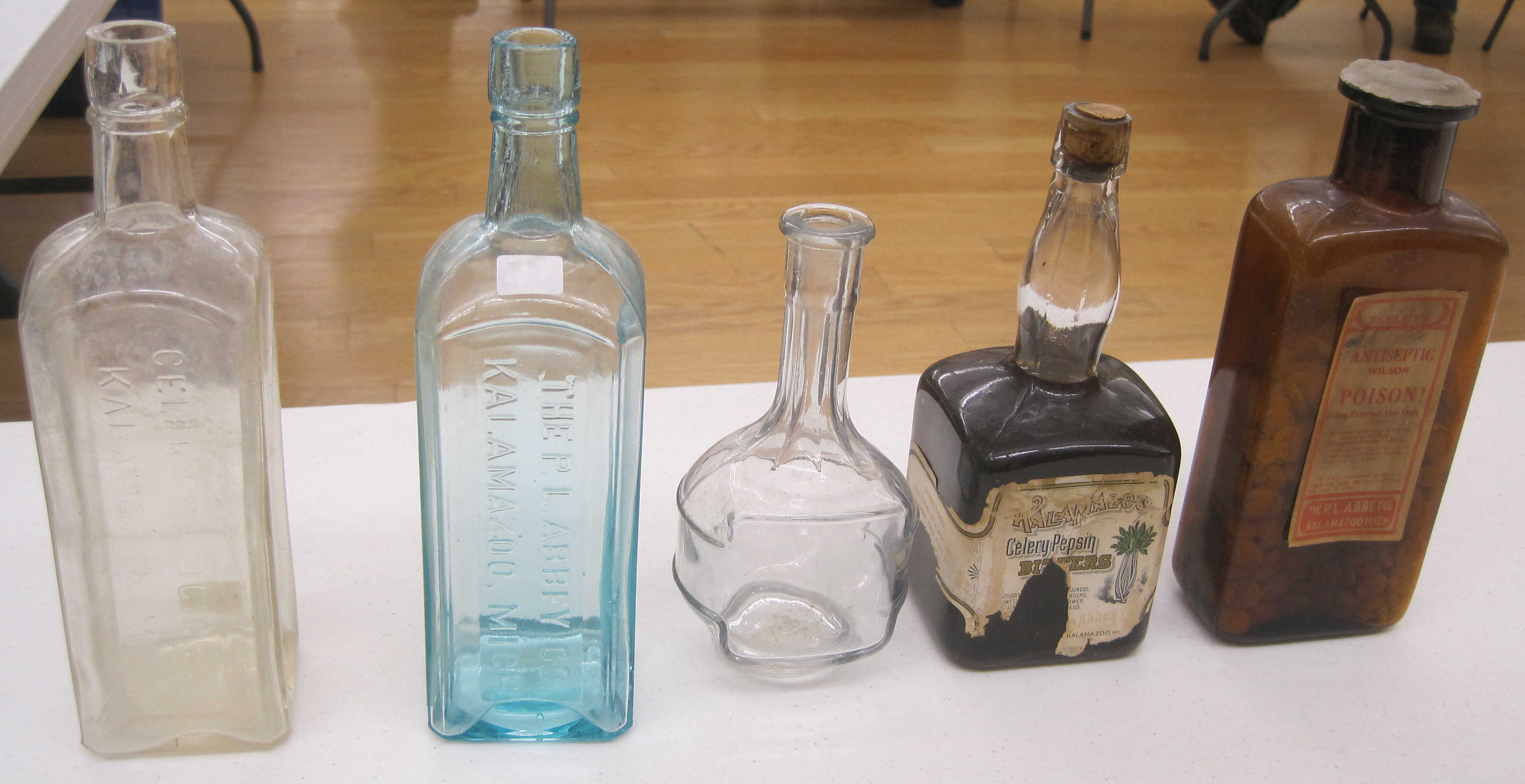 Moving on, to a really cool
bottle displayed by Scott Hendrichsen, a beautiful open-
pontiled,
Moving on, to a really cool
bottle displayed by Scott Hendrichsen, a beautiful open-
pontiled, Pualon’s Invigorator. 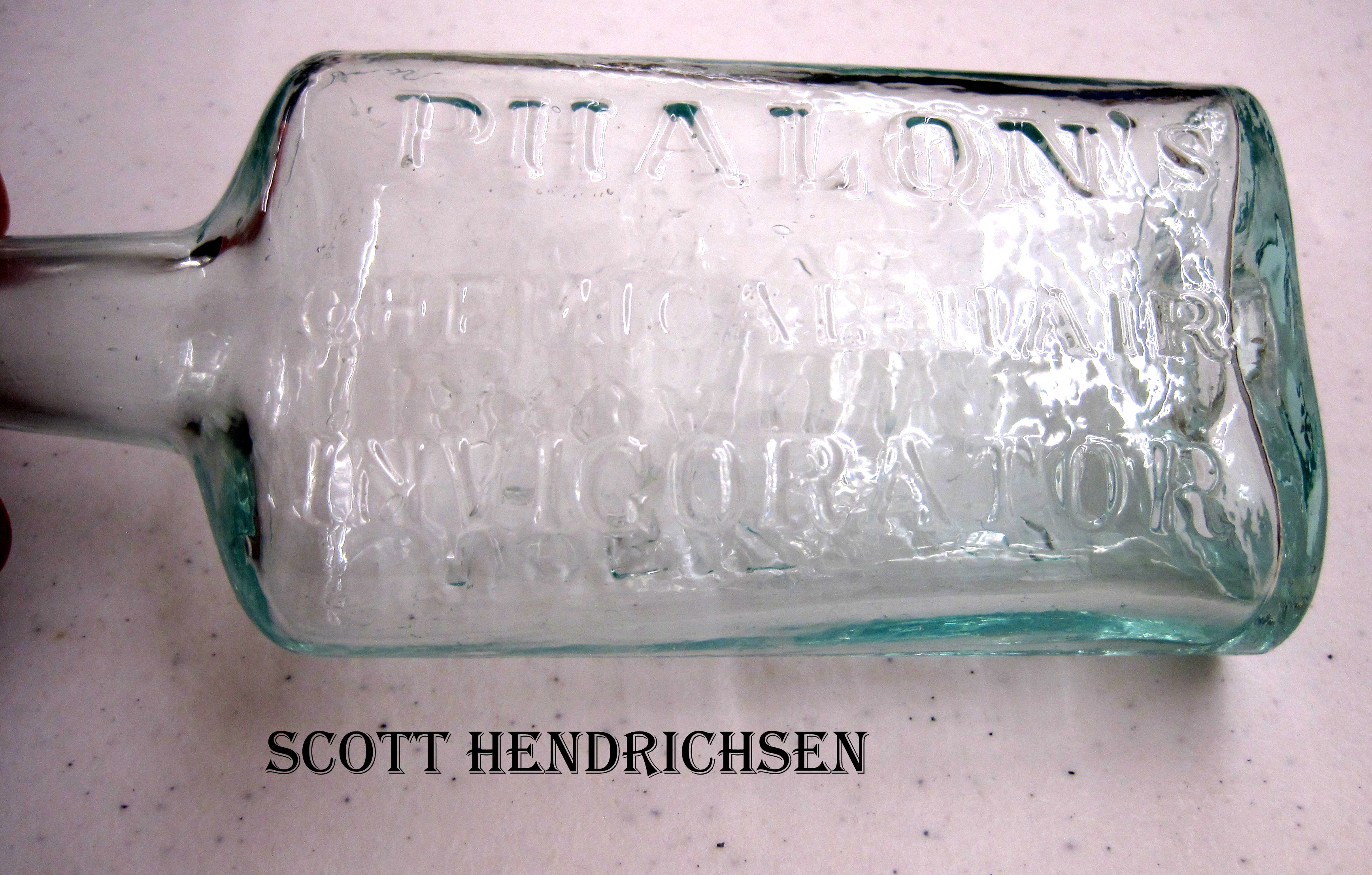 My business is directly related to treasure hunting because I find locating hidden riches fascinating. Actually, I get as much enjoyment in the research, as the hunt itself, whether or not I find anything. Several years back, the shipwreck, SS Republic, was located by Treasure hunter Greg Stemm. Greg is considered one of the best the deep-ocean explorers and treasure hunters in the world. 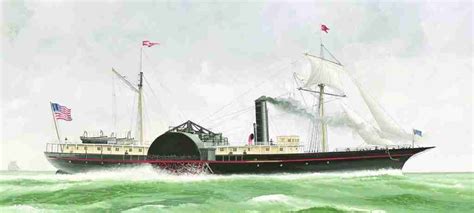 The SS Republic lies beneath 1,700 feet of water and
100 miles southeast of Savannah, Georgia. After over
140 years underwater, the hull had wasted
away, but the paddle-wheels, bell, anchor, and the
steam engine are relatively intact.
The SS Republic lies beneath 1,700 feet of water and
100 miles southeast of Savannah, Georgia. After over
140 years underwater, the hull had wasted
away, but the paddle-wheels, bell, anchor, and the
steam engine are relatively intact.The side-wheel steamer was built in Baltimore in the mid 1850's. The ship was 210 feet long and her side-wheels were 28 feet in diameter. She was originally built to accommodate only100 passengers because she was meant to transport cargo. She began her service in 1853. She then sailed to England making her the first Baltimore steamship to cross the Atlantic. After this voyage, the vessel made regular trips between the US and Central America. Soon she was modified to carry an additional 400 passengers to transport hundreds of gold seekers to California during the Gold Rush following 1849. When the Civil war began in 1861, the SS Republic was trapped in a port in New Orleans where it was confiscated by the Confederates. It was meant to be used as a blockade runner, but failed to do so. In 1864, the ship was hit by a storm. It was badly damaged and her military career came to an end. She was sold for a cheap price, repaired, and then provided regular service between New York and New Orleans. On her fifth civilian voyage, the SS Republic was hit by a hurricane and sank in 1865. The crew and all passengers successfully abandoned ship. She was heading to New Orleans full of cargo, including $400,000 in mostly gold coins that were intended to aid post-Civil War Reconstruction efforts. 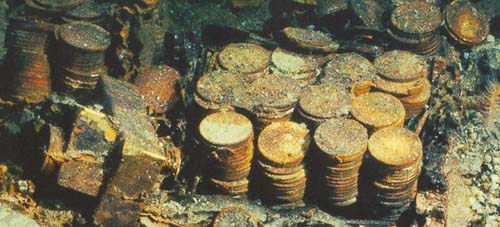 The shipwreck was located in 2003, and at the time the ship’s cargo was said to be worth 180 million dollars. Most of the recovered coins were 10 and 20 dollars gold pieces. The coins were all in very good condition. I watched the underwater salvage on TV. The filmed footage for the recovery was unedited and was broadcast just as if you were watching it live. The scene, as you watched it, was from inside the control room aboard ship. You saw what the robot operators saw from the ROV cameras. Of course the scientist on-board were running an ongoing narration as the event unfolded. At one point they were very concerned to see if all their special recovery tools would operate as planned in the extreme pressure at 1,700 feet. Another scientist began to explain to the viewer all about the pressure they were dealing with, and just how extreme the pressure was. He said, “For example we will not see typical wildlife or species of fish at this depth, because if they weren’t crushed, they couldn’t breath as fish do.” At that exact moment a shark swam by the camera as if God said, “I will determine that.” They used underwater robots to cover-over the stacks of coins with tubes. Then, a fast setting silicone type material would be injected into the tubes. Within minutes the robot could pick up the stacks and put them into a recovery basket. Originally when the cargo was loaded aboard ship, the coins were packed in wooden boxes, and over time the wood rotted away leaving thousands of gold coins still neatly stacked! I say all this, to tell you . . . other treasure was also uncovered, in the form of antique bottles! Like the gold, the glass survived! One of the products listed on the Republic’s manifest were bottles of Pualon’s Invigorator! In the 1840's Edward Phalon was already well known, because of his famous Chemical Hair Invigorator. The New York hairdresser and wig-maker introduced his hair treatment in the early 1840s in the lavish Franklin House establishment on Broadway. This richly embellished bathing and hair-cutting emporium boasted elaborately painted walls and Italian marble flooring, with “sumptuous” interior furnishings of rosewood and crimson velvet. An advertisement from 1849 for Franklin House, promoted his Chemical Hair Invigorator. It was said to “clear the pores, dissolve impurities and keep the hair moist. . . .” Around 1858, Phalon was joined by son Henry and the company became Phalon & Son’s Perfumery, offering an extensive line of perfumes, hair dyes, and even a Bear Oil. Seventy Seven bottles of Phalon’s Invigorator, in two sizes, were recovered from the SS Republic. 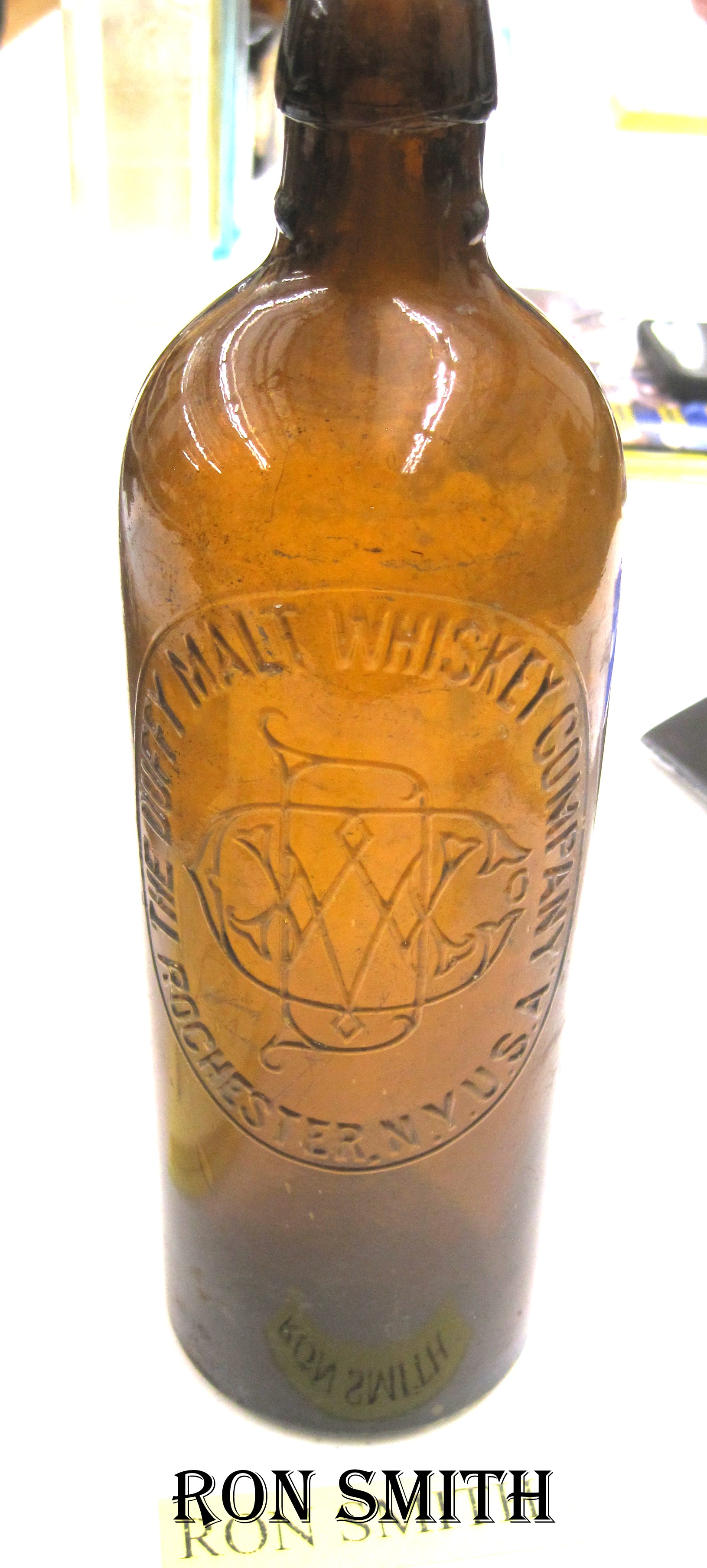 Ron
Smith displayed one of the first antique
bottles I ever owned! A Duffy's Pure Malt Whiskey
bottle! Honestly this is the one that really got me
started in collecting! And looking back with a
greater understanding of antique bottles I can say,
this beauty has a lot going for it!
Ron
Smith displayed one of the first antique
bottles I ever owned! A Duffy's Pure Malt Whiskey
bottle! Honestly this is the one that really got me
started in collecting! And looking back with a
greater understanding of antique bottles I can say,
this beauty has a lot going for it!First it is just the right size and the color is one cherished by most collectors . . a deep honey amber! It has a nice droopy (we love crude) applied lip. And the embossing is strong and neatly arranged. Not to mention, it actually qualifies as a monogram bottle! Which is a collecting category of itself. Duffy’s Malt Whiskey was promoted for more than an intoxicant, but as "medicine for all mankind!" Giving new meaning to the phrase “Medicinal Use.” It was promising to act as a curative agent for any number of maladies, including consumption, catarrh, pneumonia, malaria, bronchitis, croup, diphtheria, cholera, dyspepsia, as well as stomach and heart problems. I think it embodied all the medicinal properties of Zoa-Phora! 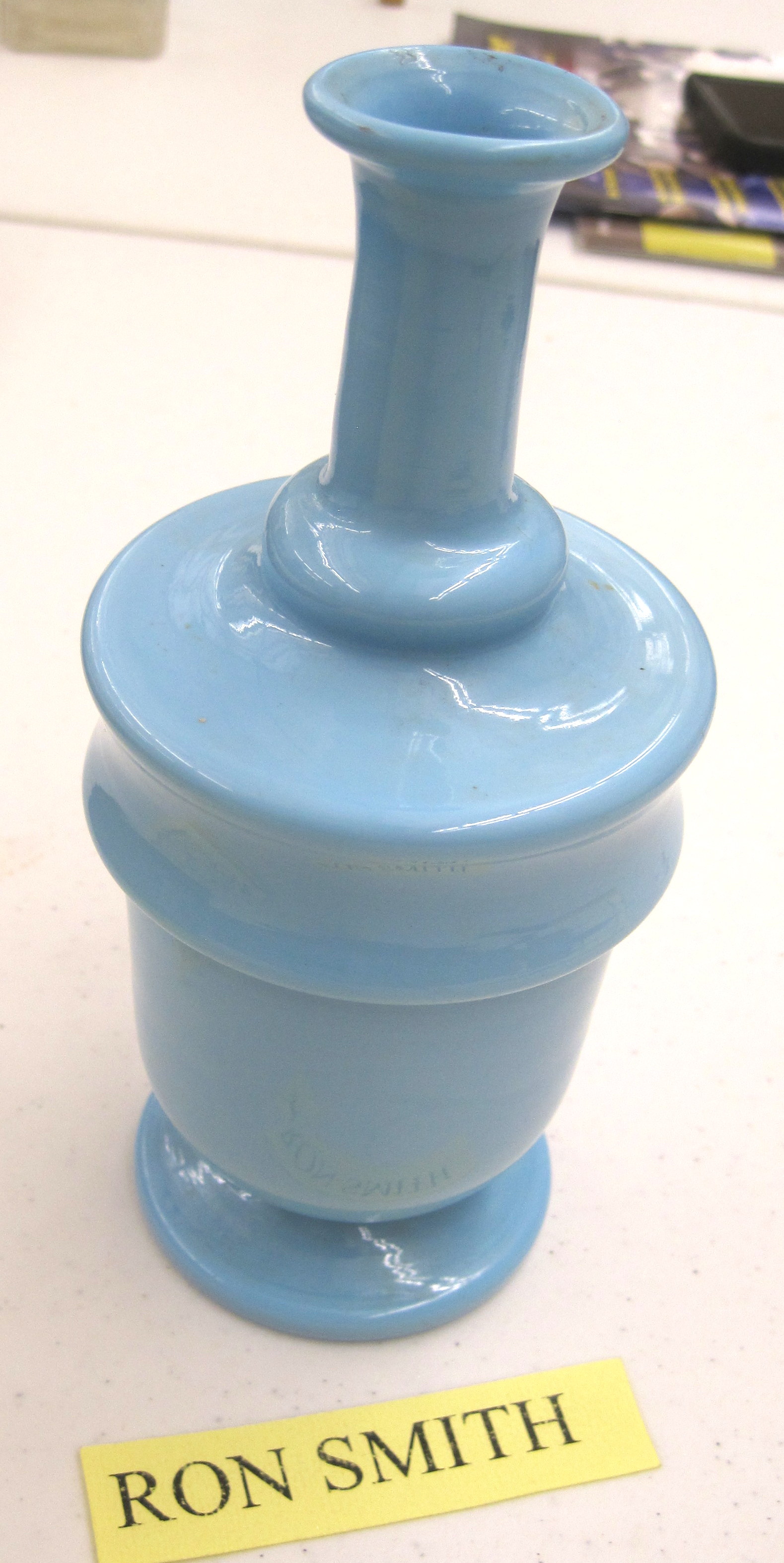 The downside? They made a million of these! I remember when Jack Short and Ernie Lawson were actively dump digging in Kalamazoo they would share finding school bus-sized rich veins of Duffy bottles! Hey, I still think they are way cool! Ron had another very interesting decorative bottle. I think it is about 8 inches high with a sculpted body, it has a long narrow neck and a wide flared-lip. It is a form of powder-blue milk glass which was hand blown-in-a-mold as a vase. It has a very clear open pontil-rod scar. Researching these decorative vases, most seem to be imported from Italy. 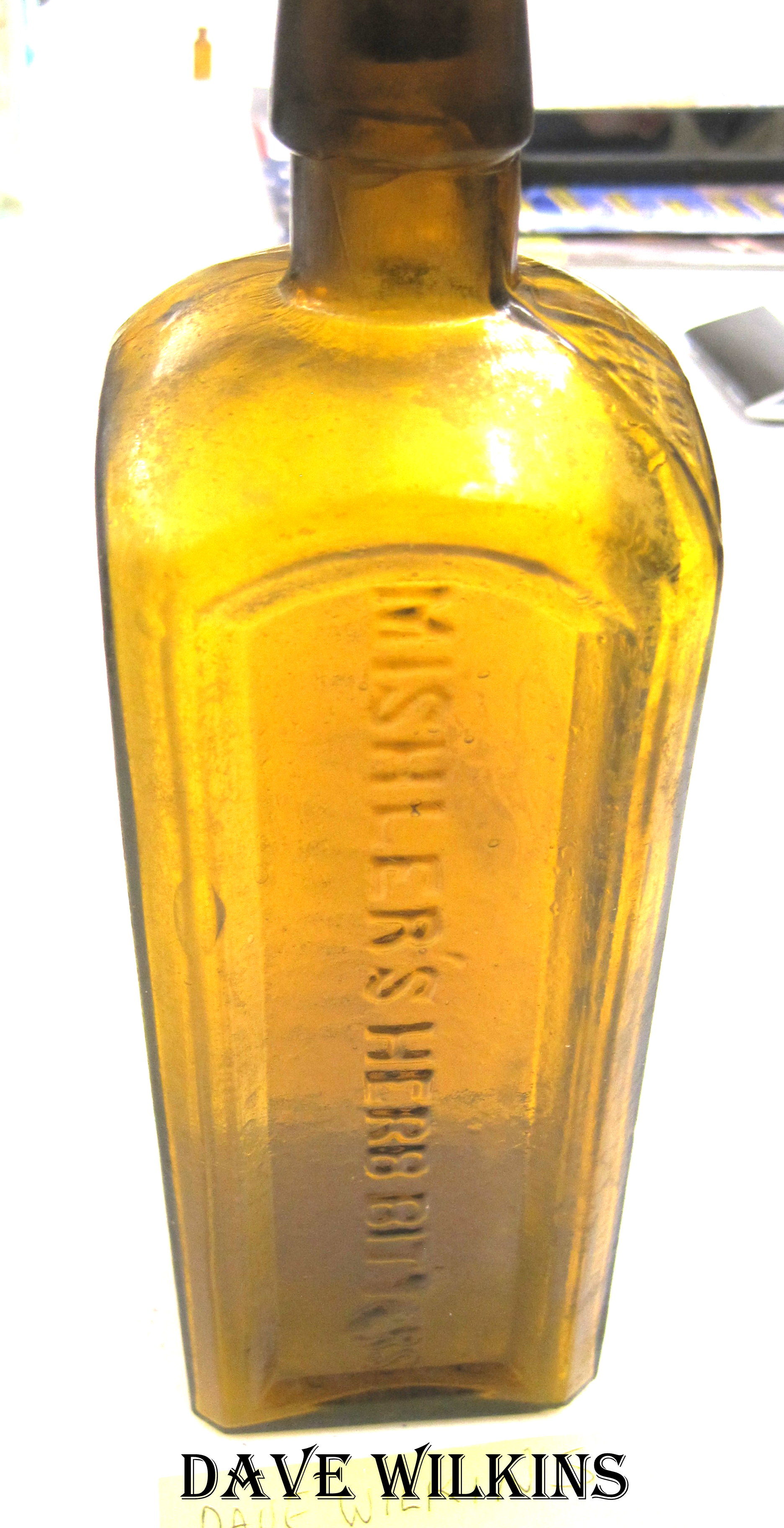
Dave Wilkins showed us yet another sweet Bitters Bottle this month! Last month Dave had the P.L. Abby Kalamazoo Celery Pepsin Bitters bottle. This last meeting he showed us a Dr. S.B. Hartman & Co. “Mishler’s Herb Bitters” It is a honey- amber color with a tooled applied mouth. I went to my 1996 Auction Price Report first. OK, I know 1996 actually pre-dates the Internet auction sites like e-Bay, so the rarity of many antiques were yet unclear. From the 96 report, I learned there were 3 variants known as: M-99, M-100, M-101, I would say Daves fits into M-100. According to my book M-100 is the most valuable. At the time of this book printing the average sold for $150 -$250. I ruled out the M-99, which is marked with table spoon graduations, and its base is embossed. The later version, M-101, had left off the ‘Dr. S.B. Hartman’ and it appears to be the most common. There is another Mishler Bottle which is “E. Mishler’s (Evan Mishler) Wild Cherry,” embossed with the bust of a pretty woman and was sold to be used as a master back-bar bottle. In 1996 that one sold for just under $900.00! When a web search turns up, not one single e-Bay link, brother you got a keeper! 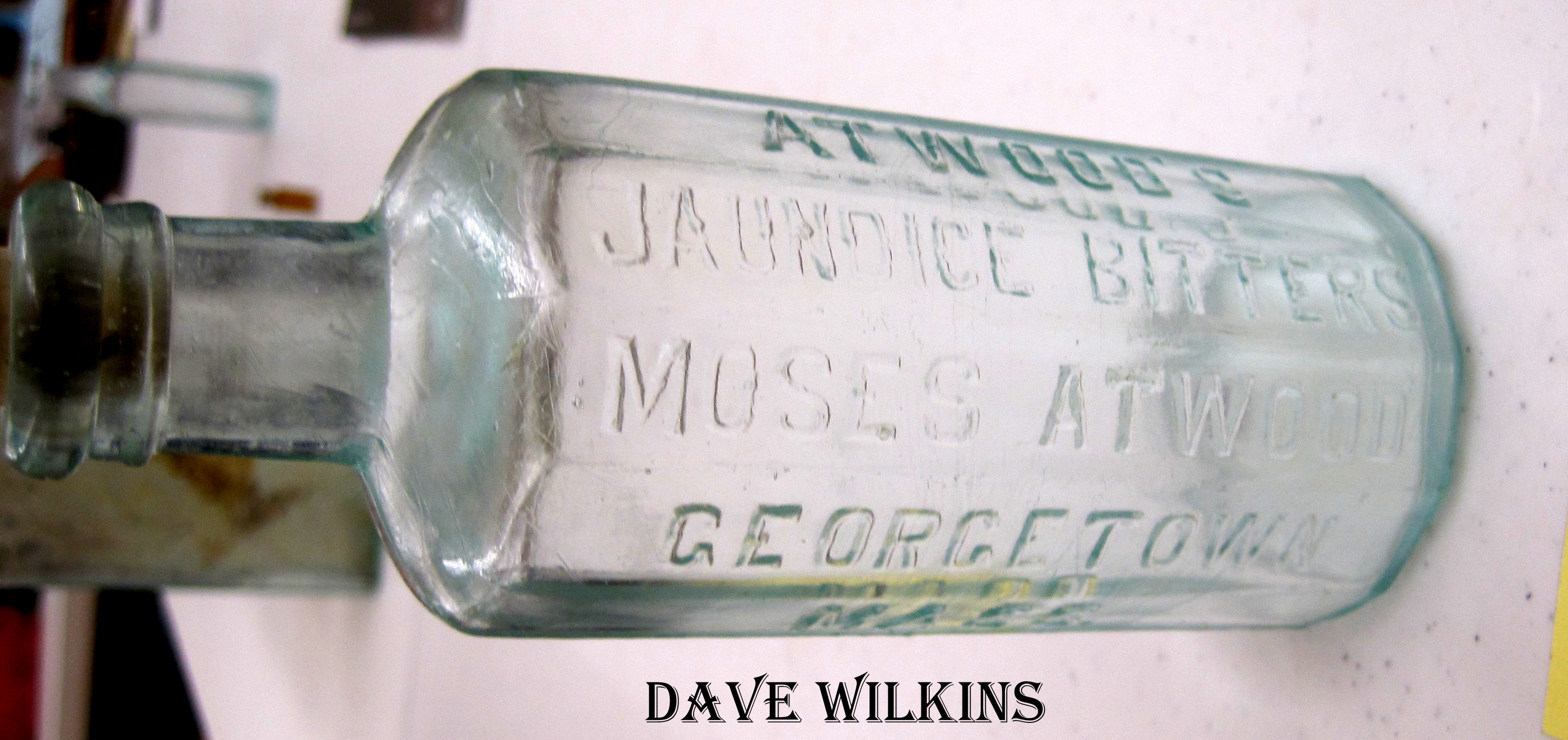 Dave also showed a nice
little
Dave also showed a nice
little Moses Atwood Jaundice Bitters Bottle. Most collectors are familiar with these handsome little bottles with the aqua-color and the panel sides. They came in about 6 different variants and many from the 1840's & 1850's are open pontiled. What is interesting is when you try to find some ailment this stuff wouldn’t cure! Moses Atwood himself was out of the picture by the late 1850's and the product was no longer made in Georgetown Mass. As many as three other companies started producing the product one in Iowa and another in New York but the bottle continued to say Georgetown Mass. The final variant was paper labeled Atwood’s Quinine Bitters. The variant Dave has is A-123 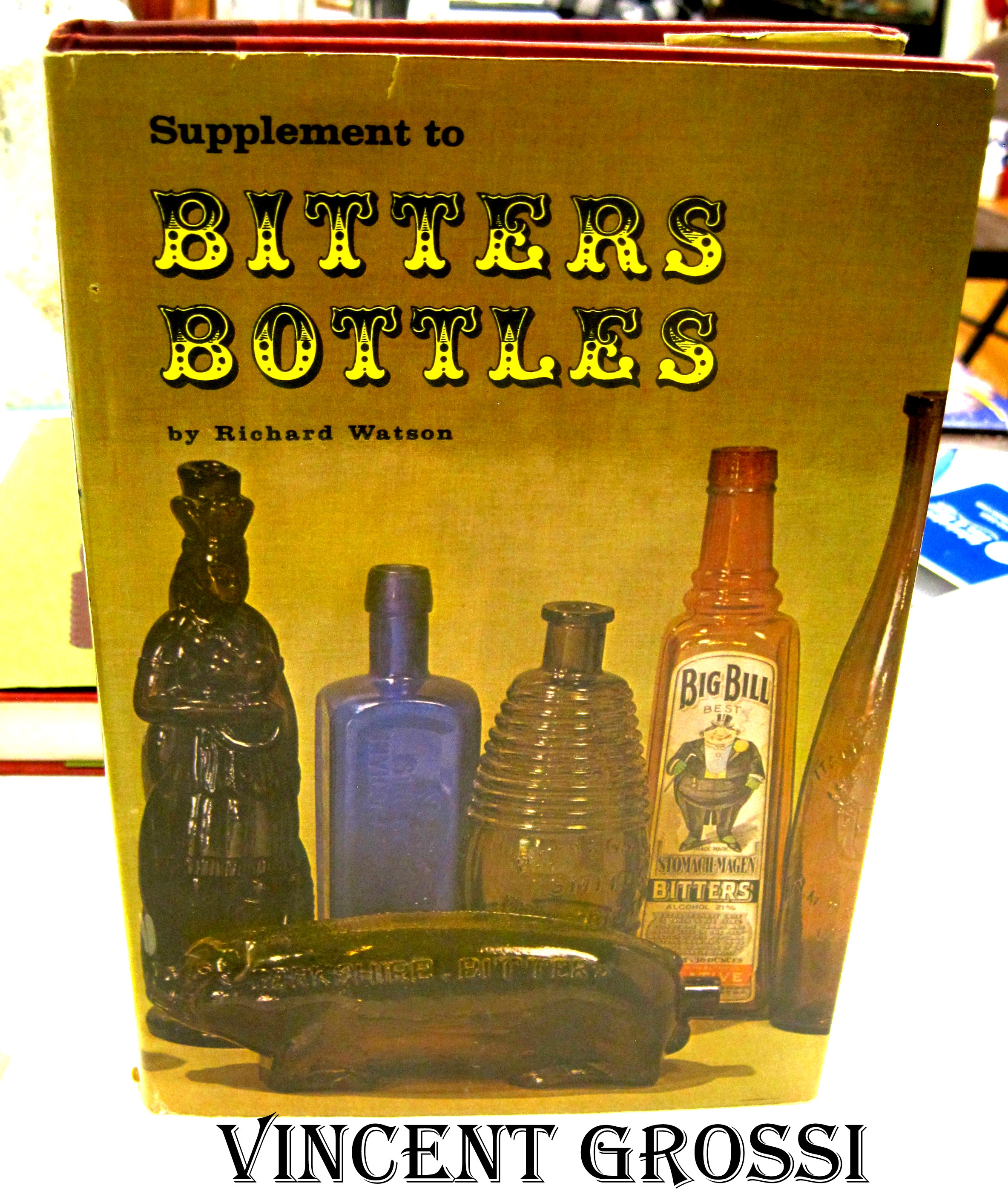 Vincent Grossi
had some sweet items at the meeting including some
antique books, on Vincent Grossi
had some sweet items at the meeting including some
antique books, on 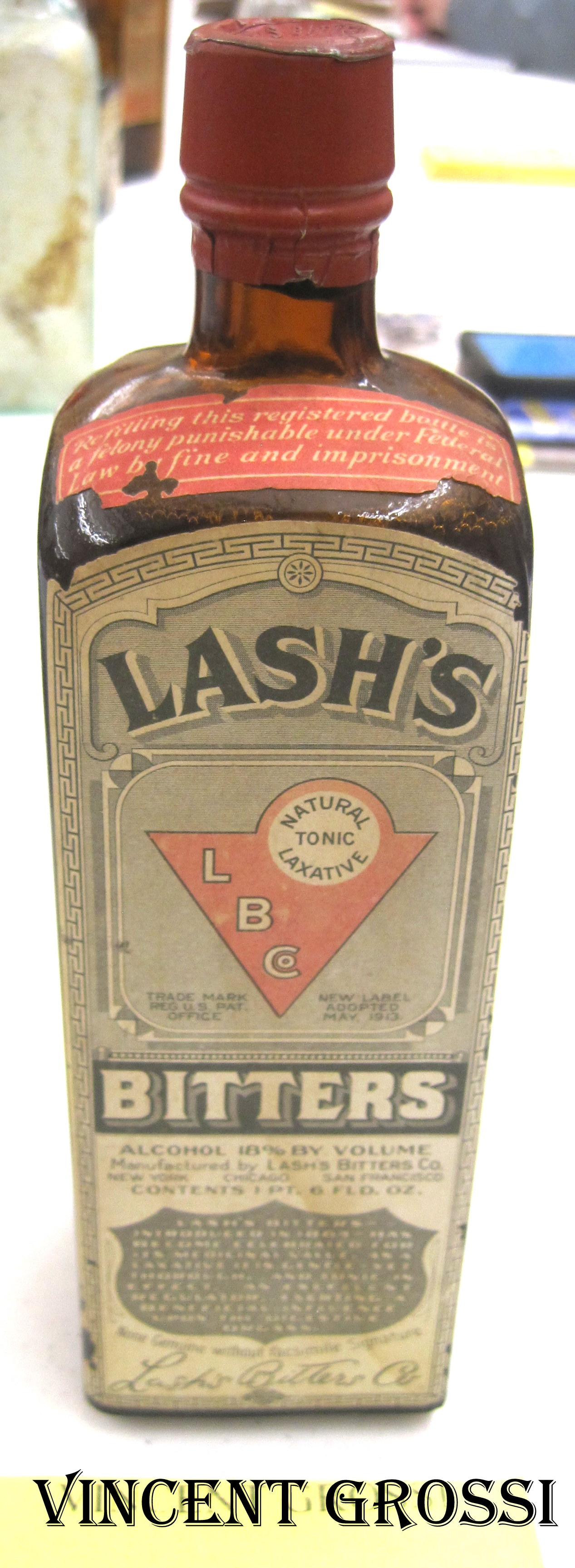 antique bottles!
But his best item is a beautiful fully labeled Lash’s Natural
Tonic Laxative Bitters. antique bottles!
But his best item is a beautiful fully labeled Lash’s Natural
Tonic Laxative Bitters.Lash’s Bitters were first bottled in the mid-1880's, and continued in business up until 1960's! Going by the sticker on Vincent’s bottle I would place it after 1935. This is based on the sticker which reads “Refilling this Registered Bottle is a felony Punishable under Federal Law by fines and Imprisonment.” America was on a war against bootleggers right after prohibition. 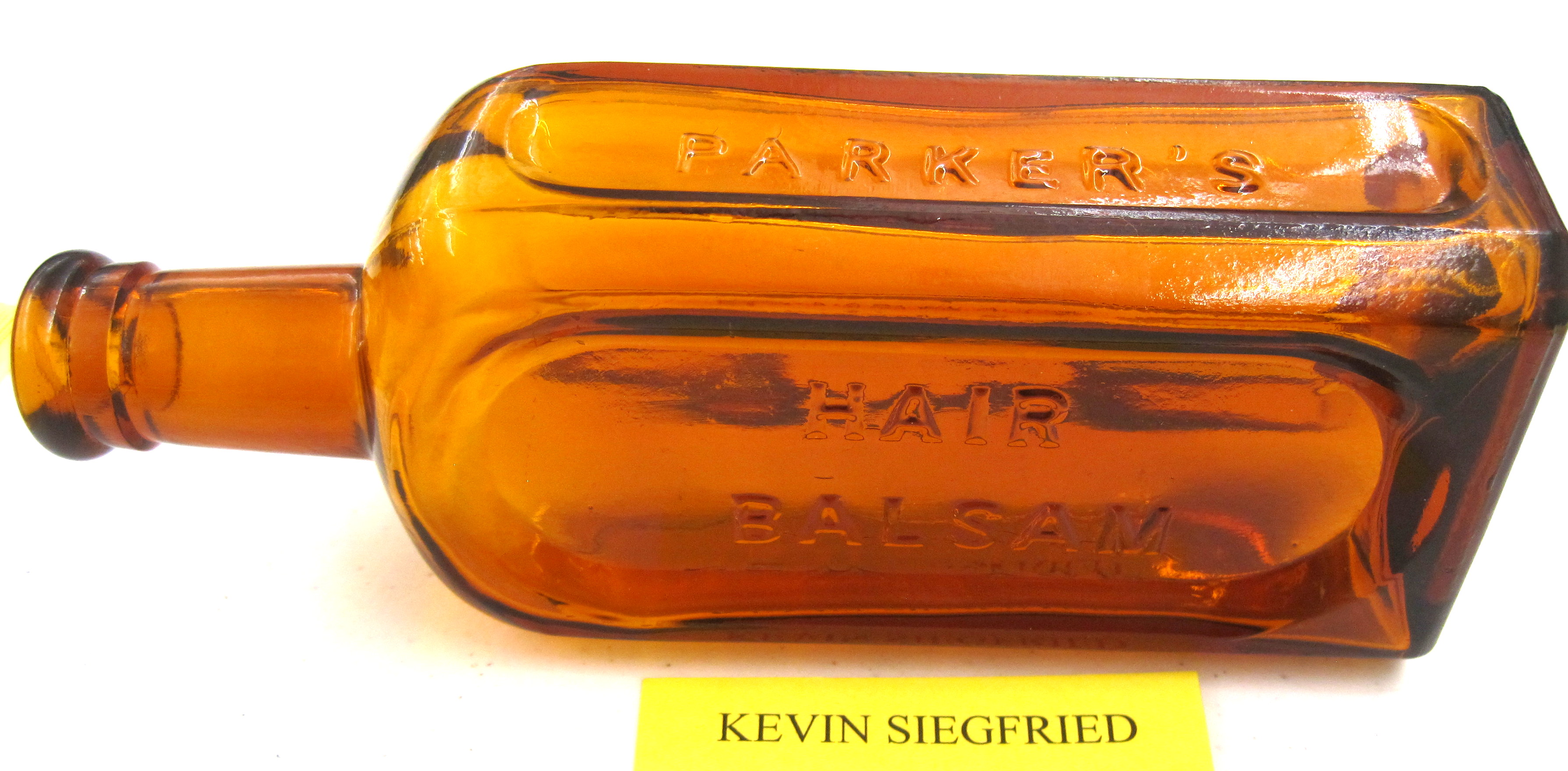 Kevin
Siegfried had a sparkling example of a Kevin
Siegfried had a sparkling example of a Parker’s Hair Balsam, with what I think of as a 2-ring applied tooled mouth. These bottles came in different sizes and colors. Kevin’s is a nice honey amber. They also came in aqua and olive green. The company dates back to the mid-1890's. They put out some great Victorian trade cards! 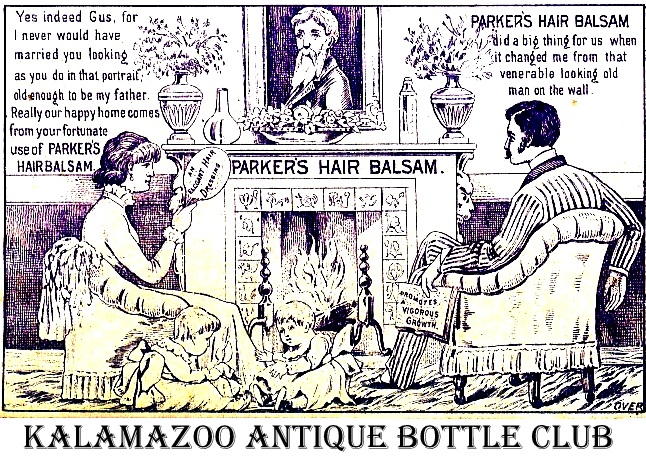 My old pal, Ed Nickerson brought in a beautiful example of a collector’s favorite, Dr. J. Hostetter’s Stomach Bitters. Like the Munyon’s Paw Paw, Dr. Hostetter’s is once again being marketed and sold online! When you go to their respective web pages, you have to confirm your age of 18. At age 72 I had to lie to get in. The original Dr. J. Hostetter’s “Celebrated” Stomach Bitters was formulated in the early 1800's by native Pennsylvanian, DR. JACOB HOSTETTER. 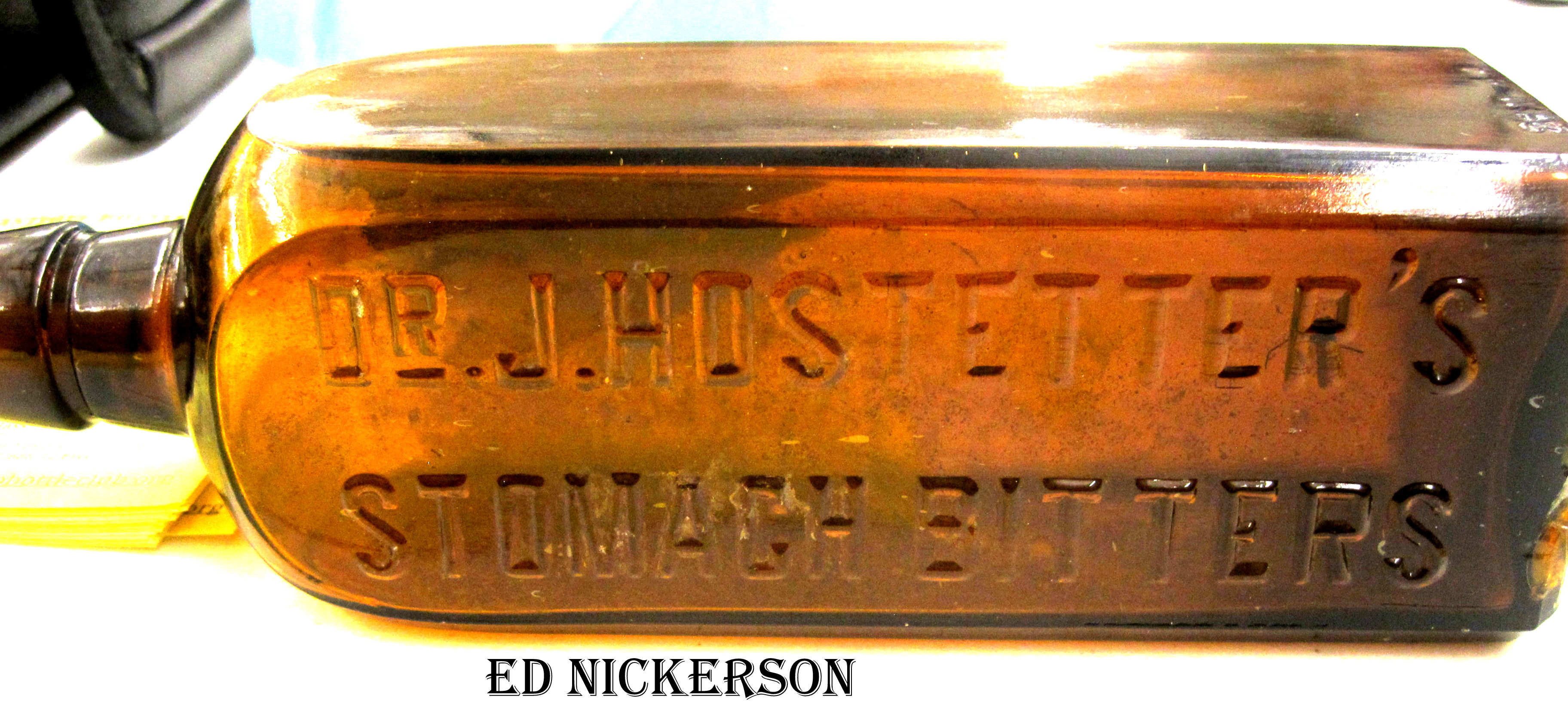 In 1853, his son David commercialized the formula –
macerated only in the pure essence of Monongahela
RYE . The product would go on to sell more than “FIFTY MILLION!”
bottles.
In 1853, his son David commercialized the formula –
macerated only in the pure essence of Monongahela
RYE . The product would go on to sell more than “FIFTY MILLION!”
bottles.During the CIVIL WAR, Dr. J. Hostetter’s “Celebrated” Stomach Bitters was rationed to UNION SOLDIERS as “a positive protective against the fatal maladies of the Southern swamps, and the poisonous tendency of the impure rivers and bayous.” At 40 proof it had to kill some bugs and enhance bravery! With 20% Alcohol she had some kick! Today’s NEW reformulated BITTERS combines ORIGINAL ingredients with aromatics & botanicals, rose & candied fruit, and the ‘RED CARMINE’ extract of the cochineal cactus beetle. This means instead of using the harmful Red Dye #2 and #40 (which were found to be unhealthy) they use a red found in ground up bugs . . . so you will enjoy a healthy experience. Dr. J. Hostetter’s Bitters bottles are a beautiful classic antique bottle but you can well imagine with sales of 50 million they are not hard to find! I was on a dig in Decater MI with friends, and Mark Churchill was one. My friend Chip Manion, had his daughter along on her first dig. She dug a corn-flower yellow Hostetter’s a super rare color! It was worth big bucks! When held up in the natural sunlight it was so pretty! The Kalamazoo Antique Bottle Club
Meets At the Otsego Historic Society Museum 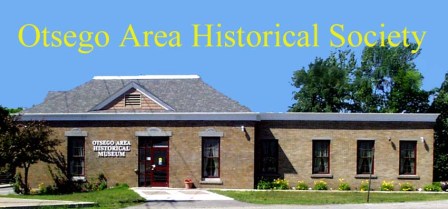 Meeting date is February 14th at 7:00 pm The Museum is located at 218 N. Farmer St. Otsego, MI 49078 Meeting starts at 7:00 Information   The Meeting theme
is Valentine’s Day
“LOVE!” BRING IN YOUR FAVORITE BOTTLE!  |
|